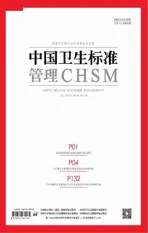外周血相关参数对肝癌预后评估价值的研究进展
2017-01-20左宏平周瑜卢震辉
左宏平周瑜卢震辉
外周血相关参数对肝癌预后评估价值的研究进展
左宏平1周瑜2卢震辉3
肝癌的发病率位居我国恶性肿瘤的第3位,居肿瘤死亡原因的第4位。研究显示炎症促进肝细胞肝癌的恶性生物学行为,并且和患者的预后相关。有研究发现了一些与患者预后相关的参数,如中性粒细胞(N)、淋巴细胞(L)、血小板(PLT)、C反应蛋白(CRP)、红细胞分布宽度(RDW)、中性粒细胞/淋巴细胞(NLR)、血小板/淋巴细胞(PLR)、C反应蛋白/白蛋白(CRP/Alb)。研究显示N的浸润与肝癌患者预后较差相关。CD4+CD25+FoxP3+调节T细胞数量增加可能导致肝癌患者生存时间减少。PLT与肝癌的发展、生长、侵袭和转移是相关的。CRP的升高与肝癌患者预后不良相关。RDW升高的患者生存率明显较差。NLR升高与肝癌术后的复发和预后有明显的相关性。升高的PLR与肝癌患者的生存率相关。CRP/Alb可能是肝癌患者独立的预后指标。上述指标目前缺乏统一的标准,具体机制尚不清楚。文章对外周血相关参数对肝癌预后评估价值的研究进展作一综述。
肝癌;外周血相关参数;预后
原发性肝癌是我国常见的恶性肿瘤之一[1]。目前肝癌的治疗是以外科手术为主的综合治疗,肝癌的治疗已经取得明显地进步,但其预后仍然很差,术后高复发率是造成死亡的主要原因[2]。如何能更早、更精确的发现肝癌术后的复发,是目前研究的重要问题。研究发现炎症与肝癌患者的预后相关[3]。最近有关研究显示外周血N、L、PLT、CRP、RDW、NLR、PLR、CRP/Alb等参数与肝癌患者预后相关,但有些指标仍存在争议,具体机制不明确。目前临床常用的评估肝癌术后复发的方法有CT、MRI、DSA、B超、AFP等,这些指标有些费用较高、有些创伤较大、有些存在假阴性的缺点。与上述检查检验相比,外周血相关参数具有更低廉、更简便的优点。本文就外周血相关参数对肝癌预后评估价值的研究进展作一综述,为今后评估肝癌预后提供新方法和新思路。
1 中性粒细胞(N)
N通过肝细胞生长因子可以增强人类肝癌的侵犯能力,与肝癌患者预后较差相关[4]。可能的机制是:(1)N来源的氧自由基,如:髓过氧化物酶形成的次氯酸分子已经被证明与基因突变和DNA损伤有关[5];另外,次氯酸分子也可以刺激一些蛋白酶,如:基质金属蛋白酶-2、7、8、9,而且可以使金属蛋白酶-1抑制物失活,增强基质金属蛋白酶-9的活性有利于癌细胞的扩散[6]。(2)Kusaba等研究发现肝硬化患者的N寿命通过加速离体凋亡变得更短暂[7]。
2 淋巴细胞(L)
循环CD4+CD25+FoxP3调节性T淋巴细胞明显增加和肝癌患者疾病进展是相关的,其数量增加可能导致CD8+T细胞功能紊乱和肝癌患者生存时间减少[8],其机制可能是:调节性T细胞相关的分子在肿瘤浸润和无肿瘤浸润的淋巴细胞中表达不同,这显示出肿瘤微环境可能增强FoxP3在CD4+CD25-和CD4+CD25+T细胞中的表达。最近在鼠荷瘤模型中的一项研究显示CD4+CD25-T细胞的转变是获得CD4+CD25+Fo-xP3+调节T细胞的主要机制[9]。
3 血小板(PLT)
研究发现,PLT与原发性肝细胞肝癌的发展、生长、侵袭和转移是相关的,其发生机制是:(1)肿瘤可以导致凝血物质和PLT活化的改变,PLT能够产生一些促进肿瘤生长的因子,促进肿瘤的生长与转移[10];(2)PLT通过形成集群样的肿瘤细胞,提高肿瘤细胞的生存率,从而在脉管系统中形成癌栓[10-11]。
4 C反应蛋白(CRP)
CRP升高的水平与肝癌患者预后不良相关[12],其发生机制可能为:(1)共存的炎症可能增加白细胞计数,随后增加促炎性细胞因子的释放使CRP升高;(2)肿瘤宿主细胞与肿瘤坏死因子或局部组织损伤相互作用产生促炎性细胞因子,肿瘤的炎性因子可能促进肿瘤的生长,因此可能进一步促进系统性炎症反应[13]。
5 红细胞分布宽度(RDW)
术前RDW升高(>14.5%)的患者比RDW减低(≤14.5%)的患者生存率明显较差。多因素分析显示:RDW升高、TNM分期、肿瘤大小、肿瘤数量和血管侵犯是肝癌患者预后的独立危险因素[14]。其发生机制可能是:(1)RDW升高被认为可以反映炎症程度,影响癌症患者的生存[15];(2)RDW升高与铁代谢、抑制对促红细胞生成素的反应有关,而且通过产生炎性反应物减少红细胞的寿命[16]。
6 中性粒细胞与淋巴细胞的比值(NLR)
升高的NLR已经被发现在肝癌患者接受肝移植术后[17]、根治性肝切除术后[18]等治疗后的复发和预后有明显的相关性。其可能的机制是:NLR的升高是由于巨噬细胞渗透进入肿瘤细胞,而且肿瘤细胞的增加与巨噬细胞的活动有关,这可以导致中性粒细胞增加和/或淋巴细胞减少。而且中性粒细胞的数量与肿瘤细胞黏附到肝血窦以及肿瘤细胞运动能力是相关的,这可能跟肿瘤的转移有关。淋巴细胞减少可以导致特异性肿瘤T细胞减少,这使得机体抗肿瘤免疫变得脆弱[17]。关于NLR预测肝癌术后复发有很多争议,有研究发现肝切除术后肝癌患者的术前NLR与总体生存率(OS)和无复发生存率(RFS)没有明显的联系,反对NLR作为决定治疗的指标[19]。并且关于NLR的截断值是有争议的,Mano Y等日本人研究发现能够预测肝癌患者术后复发的NLR截断值是2.81[19],而我国Liu Yue等研究显示NLR截断值是2.75[20]。
7 血小板与淋巴细胞比值(PLR)
研究显示,升高的PLR与肝癌患者的总体生存率、无病生存率、无复发生存率相关[21],其可能的机制是:(1)血小板能够促进肿瘤的转移,激活的血小板通过内皮细胞,能够阻止肿瘤细胞被免疫系统的清除[22];(2)血小板分泌的生长因子包括:肿瘤生长因子-β、血管内皮生长因子和血小板反应蛋白-1,这些生长因子可以刺激肿瘤细胞增殖和黏附于其他细胞,导致肿瘤生长和转移[23]。PLR与NLR相似也有很多争议,Liu Yue等研究结果显示PLR不能作为评估肝癌患者术后复发的指标[20],今后仍需要进一步研究。
8 C反应蛋白/白蛋白比值(CRP/Alb)
在肝癌患者中CRP/Alb比值可能是一个独立的预后指标,CRP/Alb比值升高(≥0.037)与肿瘤进展和肝脏储备功能减低是相关的[24]。其可能机制为:系统性炎症反应会导致CRP升高,并且伴随体质量减轻和脂肪组织丢失,进一步导致癌症患者全身状况变差和死亡率增加[25]。由于肝癌患者潜在共存疾病和有可能损害的营养状态有助于肝硬化的发生。损害肝脏储备功能使得肝癌患者的肝硬化加重,比起以前肝脏合成CRP和Alb都正常的患者,在这些患者中CRP和Alb将会变得更低。
综上所述,外周血相关参数存在一些缺点。(1)相关参数有一定的争议,没有统一的标准;(2)有些研究结果相反,得出截然不同的结论;(3)大多数研究是回顾性研究,存在一定的偏倚;(4)具体机制还不清楚。但同时也要看到PLT、NLR、PLR等相关参数在评估肝癌预后的价值。目前临床上对肝癌患者术后复发的评估方法有:影像学、病理检查、肿瘤标志,上述所提及的外周血相关参数比传统方法更简便、更低廉。随着研究的不断深入,上述问题将会逐渐解决。因此,外周血相关参数对肝癌患者预后评估有很好地应用前景,甚至还会对人体其他恶性肿瘤预后评估带来益处。
[1] Chen W,Zheng R,Baade PD,et al. Cancer statistics in china,2015[J]. CA Cancer J Clin,2016,66(2):115-132.
[2] Poon RT,Fan ST,CM Lo,et al. Long-term survival and pattern of recuence after resection of small hepatocellular carcinoma in patients with preserved liver function:implications for a strategy of salvage transplantation[J]. Ann Surg,2002,235(3):373-382.
[3] Sun B,Karin M. Obesity,inflammation,and liver cancer[J]. J Hepatol,2012,56(3):704-713.
[4] Imai Y,Kubota Y,Yamamoto S,et al. Neutrophils enhance invasion activity of human cholangiocellular carcinoma Cells:an in vitro study[J]. J Gastroenterol Hepatol,2005,20(2):287-293.
[5] N Güngör,AM Knaapen,A Munnia,et al. Genotoxic effects of neutrophils and hypochlorous acid[J]. Mutagenesis,2010,25(2):149-154.
[6] De Larco JE,Wuertz BR,Furcht LT. The potentialRole of neutrophils in promoting the metastasis phenotype of Tumors releasing interleukin-8[J]. Clin Cancer Res,2004,10(15):4895-4900.
[7] Kusaba N,Kumashiro R,Ogata H,et al. In vitro study of ne-Utrophil apoptosis in liver cirrhosis[J]. Intern Med,1983,37(1):11-17.
[8] J Fu,D Xu,Z Liu,et al. Increased regulatory T cells correlate with CD8 T-cell impairment and poor survival in hepatocellular carcinoma patients[J]. Gastroenterology,2007,132(7):2328-2339.
[9] Baecher-Allan C,Anderson DE. regulatory cells and human cancer[J]. Semin Cancer Biol,2006,16(2):98-105.
[10] Leslie M. Cell biology:beyond clotting:the powers of patelets[J]. Science,2010,328(5978):562-564.
[11] Takagi S,Sato S,Oh-hara T,et al. Platelets Promote Tumor Growth and Metastasis via Direct Interaction between Aggrus/ Podoplanin and CLEC-2[J]. PLoS ONE,2013,8(8):e73609.
[12] Kinoshita A,Onoda H,Takano K,et al. pretreatment serum C-reactive protein level predicts poor prognosis in patients with hepatocellular carcinoma[J]. Med Oncol,2012,29(4):2800-2808.
[13] McMilan DC,Canna K,McArdle CS. Systemic inflammatory Response predicts survival following curative resection of colorectal cancer[J]. Br J Surg 2003,90(2):215-219.
[14] T Zhao,L Cui,A Li. The significance of RDW in patients with hepatocellular carcinoma after radical resection[J]. Cancer Biomarkers,2016,16(4):507-512.
[15] Ay S,Eryilmaz MA,Aksoy N,et al. Is early detection of colon cancer possible with red blood cell distribution width? [J]. Asian Pac J Cancer Prev,2015,16(2):753-756.
[16] Bucciarelli P,Maino A,Felicetta I,et al. Association between red cell distribution width and risk of venous thromboembolism[J]. Thromb Res,2015,136(3):590-594.
[17] Halazun KJ,Hardy MA,Rana AA,et al. Negative impact of neutrophil-lymphocyte ratio on outcome after liver transplantation for hepatocellular carcinoma[J]. Ann Surg,2009,250(1):141-151.
[18] Q Wang,S Blank,MI Fiel,et al. The Severity of Liver Fibrosis Influnces the Prognostic Value of Inflammation-Based Scores in Hepatitis B-Associated Hepatocellular Carcinoma[J]. Ann Surg Oncol,2015,22(3):1-8.
[19] Mano Y,Shirabe K,Yamashita YI,et al. Preoperative neutrophilto-lymphocyte ratio is a predictor of survival after hepatectomy for hepatocellular carcinoma:a retrospective analysis[J]. Ann Surg,2013,258(2):301-305.
[20] Liu Y,Wang ZX,Cao Y,et al. Preoperative inflammation-based markers pre- dict early and late recurrence of hepatocellular carcinoma after curative hepatectomy[J]. Hepatobiliary Pan Int,2016,15(3):266-274.
[21] W Ma,P Zhang,J Qi,et al. Prognostic value of platelet to lymphocyte ratio in hepatocellular carcinoma:a meta-analysis[J]. Scientific Reports,2016(6):35378.
[22] C Groden. Tumor-platelet interaction in solid tumors[J]. Int J Cancer,2012,130(12):2747-2760.
[23] RL Stone,AM Nick,IA Mcneish,et al. Paraneoplastic thrombocytosis in ovarian cancer[J]. N Engl J Med,2012,366(7):610-618.
[24] A Kinoshita,H Onoda,N Imai,et al. The C-reactive protein/ albumin ratio,a novel inflammation-based prognostic score,predicts outcomes in patients with hepatocellular carcinoma[J]. Ann Surg Oncol,2015,22(3):803-810.
[25] CSD Roxburgh,DC Mcmillan. Cancer and systemic inflammation:treat the tumour and treat the host[J]. Br J Cancer,2014,110(6):1409-1412.
Research Progress of Peripheral Blood Relevant Parameters in the Evaluation of Prognosis of Hepatocellular Carcinoma
ZUO Hongping1ZHOU Yu2LU Zhenhui31 Clinical Medical College, Ningxia Medical University, Yinchuan Ningxia 750004, China; 2 Department of Surgery Laboratory, General Hospital of Ningxia Medical University, Yinchuan Ningxia 750004, China; 3 Department of Hepatobiliary Surgery, General Hospital of Ningxia Medical University, Yinchuan Ningxia 750004, China
The morbidity of hepatocellular carcinoma (HCC) is in the third, the leading causes of death is in the fourth in China. Recently, it is indicated that inflammation can facilitate maligant biological behaviors of hepatocellular carcinoma and associated with the prognosis of patients with HCC. It has been found that associated with the prognosis of patients for clinical commom parameters. Such as, neutrophil, lymphocyte, platelet, C-reactive protein(CRP),red blood cell distribution width(RDW), neutrophil/lymphocyte ration(NLR), platelet/ lymphocyte ration(PLR), CRP/albumin ration. Neutrophilic infiltration is associated with worse prognosis of HCC patients. It is found that increased numbers of CD4+CD25+FoxP3+Treg may bring about poor survival of HCC patients. Platelet is associated with development, growth, invasion and metastasis of HCC. Elevated level of serum CRP is associated with poor prognosis of patients with HCC. The patients with preoperative high RDW was poor survival. High NLR has been found that siginificantly associated with recurrence and prognosis of patients with HCC after curative resection. Elevated PLR is associated with overall survival overall survival, disease-free survivaland recurrence-free survival of patients with HCC. CRP/albumin ration is an independent prognostic indicator of patients with HCC. Mentioned indicators above are lack of uniform standard. Specific mechanism is unclear. Here we review the research progress in the prognostic function of the peripheral blood relevant parameters in HCC.
hepatocellular carcinoma; peripheral blood relevant parameters; prognosis
R575
A
1674-9316(2017)19-0078-03
10.3969/j.issn.1674-9316.2017.19.039
宁夏医科大学优势学科群建设科研项目(XY201508)
1 宁夏医科大学临床医学院,宁夏 银川 750004;2 宁夏医科大学总医院外科学研究室,宁夏 银川 750004;3 宁夏医科大学总医院肝胆外科,宁夏 银川 750004
卢震辉
